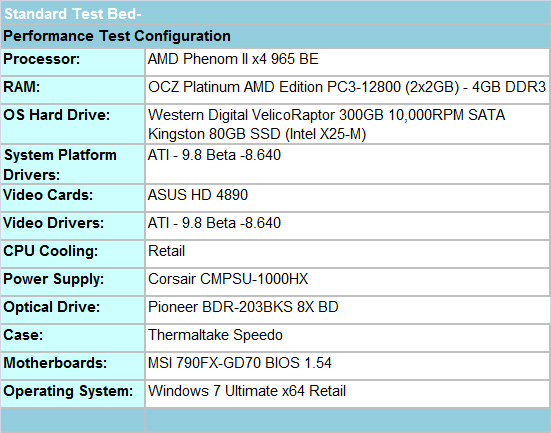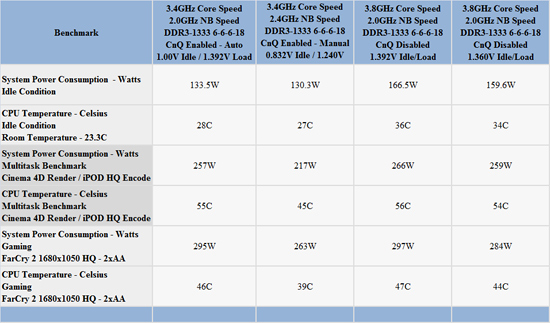Phenom II X4 965 - Can it be Undervolted?
by Gary Key on August 14, 2009 12:00 PM EST- Posted in
- Motherboards
The Phenom II X4 965 Black Edition impressed us when it launched earlier this week. Well, just about everything but the long-winded naming scheme and a slight concern about its power consumption under load conditions impressed us. Of course, the last minute change from a 125W TDP rating to a 140W TDP rating had us scratching our heads and those of the motherboard suppliers who will see a few less products certified for this processor.
That said, our first retail processor arrived in the labs yesterday. Of course, our first inclination was to test its overclocking capabilities and it reached the same 4.025GHz core speed the review sample managed on similar voltages. We did not expect any real miracles as the Phenom II tends to run out of steam around 4GHz when utilizing a 64-bit operating system. This particular chip did manage to hit 4.3GHz on 1.510V under Windows 7 x86, so it’s a keeper.
Our initial curiosity of the way, we decided to take a quick look at whether undervolting this gem of a processor could reduce its carbon footprint. After all, a stock 1.40V core voltage setting is a bit high for our tastes although an idle rate of 1.00V with Cool-n-Quiet (CnQ) enabled produced excellent results in earlier testing. Of course, undervolting is not new and all current processors can handle a certain reduction in voltages. We wanted to see just how low our first retail 965 BE could go before becoming unstable. Our best 955 BE retail CPU hit 1.220V at a lower stock core speed of 3.2GHz and we thought this would be an attainable voltage target but at 3.4GHz considering the yield and process improvements made by AMD over the past few months.

Our test bed is slightly different than the chipset launch article as we are utilizing the MSI 790FX-GD70 motherboard and an ASUS HD 4890 video card. The test results today are concentrated on undervolting this particular processor and not as a cross-platform comparison.
The power consumption tests utilize an watts up? Pro meter and we capture total power consumption for the system at the wall, less the monitor and speakers. Our faith in capturing true core temperatures with various software utilities for the Phenom II series is suspect at times based on the diode design and chipsets. Regardless if the reported temperatures are exactly true or not, the delta between settings is our primary focus today. We are using Everest 5.0.2.1810 to capture our individual core temperatures.
We let the system idle for 10 minutes before capturing the idle readings for both power and temperature. The CPU load test consists of us rendering a rather large scene in Maxon’s Cinema 4D R11 x64 while transcoding a MPEG4 file into a size friendly format for our iPOD with Mainconcept’s Reference 1.61 utility. This test ensures a 100% load on the processor from start to finish. We run FarCry 2 at 1680x1050 2xAA High Quality settings (very high on processing effects) to simulate a typical gaming session.

At a stock core speed of 3.4GHz, we were able to reduce the load core voltage from 1.392V to 1.240V and retain 100% stability with the system. The idle voltage with CnQ enabled dropped from 1.00V to 0.832V. At idle there is a slight difference in power consumption and temperatures, but nothing to get excited about yet.
However, in our CPU load test the system power consumption drops 16% and temperatures 19%. In the gaming test, system power consumption is reduced 11% and temperatures 15%. Of note is that we were able to run the Northbridge speed at 2.4GHz without increasing NB voltages at the 1.240V (1.224 actual) core setting.
We set the CPU multiplier to 19x for the overclock test which disables CnQ. Changing the HTT reference clock will allow CnQ to remain enabled and we are still running stability tests to determine core speed stability at reduced voltages. At this point, the highest stable setting on 1.36V is 17x218 for a 3.708GHz core clock with the NB at 2.4GHz, but we are still trying for 3.8GHz.
In the meantime, we set our multiplier to 19x with an HTT reference clock of 200, resulting in a 3.8GHz core clock. The lowest voltage we could set was 1.36V and retain stability in a wide variety of benchmarks. The CPU load test indicates a 3% reduction in power consumption and a 4% drop in temperatures. The game result is better with an earth friendly 5% reduction in power and temperatures dropping 7%.
Of course, your mileage will vary based on the quality of the processor, but our initial tests indicate there is an opportunity to reduce both power consumption and temperatures up to 16% and 19% respectively at stock settings by undervolting the 965 Black Edition processor. We have an additional retail processor arriving shortly and will provide a short update on the final test results at that time. For now, it appears this processor can be saved from the gas guzzler tax.
















40 Comments
View All Comments
blackshard - Monday, August 17, 2009 - link
Take a look here for example:http://www.anandtech.com/cpuchipsets/showdoc.aspx?...">http://www.anandtech.com/cpuchipsets/showdoc.aspx?...
2.66 Ghz i7 has higher power consumption than 955BE. Not talking about performance per watt, 955BE is rated at 125W and i7 is rated at 130W.
Also consider that in the Phenom I period no AMD motherboards had any kind of energy saving feature like DES/EPU. This lead to overgrown power requirements for phenoms (parts ate too much current + no optimization in voltage regulation on the mobos). Now the situation is far better because there exist EPU/DES/Dr.Mos features for AMD, and AMD 45nm are much more competitive with intel 45nm parts.
strikeback03 - Thursday, August 20, 2009 - link
Those are total system power measurements, not CPU-only measurements. I wasn't talking performance per watt either, I was comparing measured power drawn by the CPU only to the rated TDP of that CPU, and pointing out that Intel has traditionally been much more conservative in the TDP assigned to processors than AMD has.blackshard - Thursday, August 20, 2009 - link
Sure they are measurements of the total system power, but actually they have comparable idle power requirements, and other components are comparable too, so with some margin of error (including PSU and VRM efficiency) you may obtain some sort of raw cpu power usage.About "traditional" TDP, Intel states that their TDP is calculated on a typical load, while AMD states that their TDP is calculated on maximum load, impossible to achieve in a normal condition.
If you jump the core2 era, Intel wasn't so conservative and, just to push some meaningless numbers, looks like it will not be so conservative even in the near future:
http://www.hwupgrade.it/articoli/cpu/2264/consumo_...">http://www.hwupgrade.it/articoli/cpu/2264/consumo_...
AFAIK all core i7 processors have the same TDP of 130W, while 965BE has 140W TDP. i7 have the power consumption advantage of DDR3-1333 Mhz instead of DDR2-1066 Mhz of the AMD setup, and idle power consumption is comparable (4W of difference)
strikeback03 - Friday, August 21, 2009 - link
Intel wasn't conservative with Core2? you mean like the 136W TDP QX9770 that draws 86W at full load?destrobig - Saturday, August 15, 2009 - link
Those tables look they got hit with an ugly stick. Two separate ugly sticks by the looks of it.MadMan007 - Saturday, August 15, 2009 - link
Bery nice but are there any plans do do this for any other CPUs? Ime over the last two years every CPU can be undervolted a decent amount at stock and save a noticable amount of power, this isn't unique to this CPU obviously. It might be interesting to see how much other CPUs can have their power draw decreased by optimizing voltage.gigahertz20 - Saturday, August 15, 2009 - link
Gary Key: "Damn, I wonder what that thing on my desk is then" when referring to if AMD has final RV870 silicon.Any other tid bits of info Gary? Benchmarks on Sept. 10th maybe....or later?
Roland00 - Sunday, August 16, 2009 - link
And you won't get any new info till September 10th due to Non Disclosure agreements.deputc26 - Friday, August 14, 2009 - link
for what it's worth my 940 can do 1.22v minimum at stock 3.0ghz. 3.4ghz requires 1.3875vciparis - Friday, August 14, 2009 - link
[quote]the last minute change from a 125W TDP rating to a 140W TDP rating had us scratching our heads and those of the motherboard suppliers[/quote]That sounds rather friendly :)